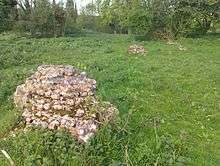Hempton Priory
| Hempton Priory | |
|---|---|
| The Priory Church of Saint Stephen, Hempton | |
 Priory ruins, 2012 | |
 Hempton Priory | |
| 52°49′N 0°50′E / 52.82°N 0.83°ECoordinates: 52°49′N 0°50′E / 52.82°N 0.83°E | |
| Location | Hempton, Norfolk |
| Country | England |
| Denomination | Roman Catholic |
| Architecture | |
| Years built | 1135 |
| Demolished | 1536 |
Hempton Priory was a priory in Norfolk, England. Very few surface remains can be found, although substantial earthworks can be seen and the foundations of a long building have been noted as incorporated into a later building.
History
Hempton Priory was founded as a hospital before 1135 (during the reign of Henry I) by Roger de St Martin (St Martins), with Richard Ward (who became the first prior when the hospital became a priory). It was an Augustinian church, and was alternatively referred to as Fakenham, Damsend or Hampton Priory.
King John granted rights to a fair to Hempton Priory,[1] later rising to three fairs a year.[2] The prior claimed a market on Tuesday, which was noted as being long obsolete in White's Directory of 1854, with no vestiges of the priory being seen at that time.[3] The net income from its estates in 1535 was £32 14s. 8d.[4]
The priory continued to be used as a hospital after 1200, being dissolved 1536 with the land granted to Sir William Fermer in 1545/6.[5] The land was subsequently passed to Lord Viscount Towsnhend.
Priors
- Simon was prior Ao. 12th of Henry II.
- Richard occurs as prior, in the 54th of Henry III.
- Guy Ferret occurs prior
- In 1301, Richard de Westacre, was admitted as prior.
- Alan de Lenn, prior.
- 1339, Nicholas de Kettleston.
- 1386, John de Snoring, prior.
- 1393, John Pencthorp.
- John occurs prior in the 4th of Henry IV.
- John occurs prior, about the 15th.
- Richard occurs prior in the 17th and the 28th of Henry VI.
- Stephen Wighton, a canon of Westacre, was elected prior in 1451, and October 2d, confirmed by the Bishop.
- In 1481, John de Lexham, alias Penton, admitted prior, and occurs in 1504.
- William Fakenham, prior.
- John Sambrook occurs prior in the 21st of Henry VIII.
- In 1534, Henry Salter occurs as prior.
Priory seal
The seal of the priory was oblong in shape, of red wax, showing an image of St Stephen standing under an arch between two tapers, with the legend 'SIGILLUM COMMUNE SANCTI STEPHANI DE HEMPTON'. Under this was an image of the prior kneeling under an arch.
References
- ↑ An essay towards a topographical history of the county of Norfolk, Volume 3
- ↑ Hempton
- ↑ http://apling.freeservers.com/Villages/Hempton54.htm Norfolk - Hempton, Francis White's History, Gazetteer and Directory of Norfolk 1854, pp. 698-699]
- ↑ Religious House: Hempton or Damsend or Fakenhamdam priory Norf. Augustinian canons
- ↑ PASTSCAPE - Hempton Priory